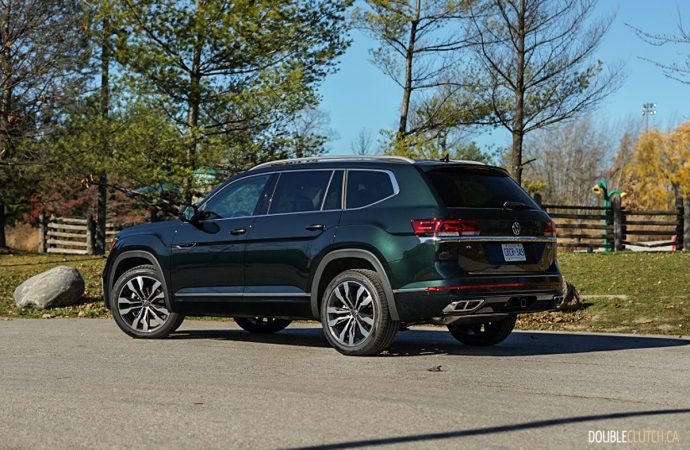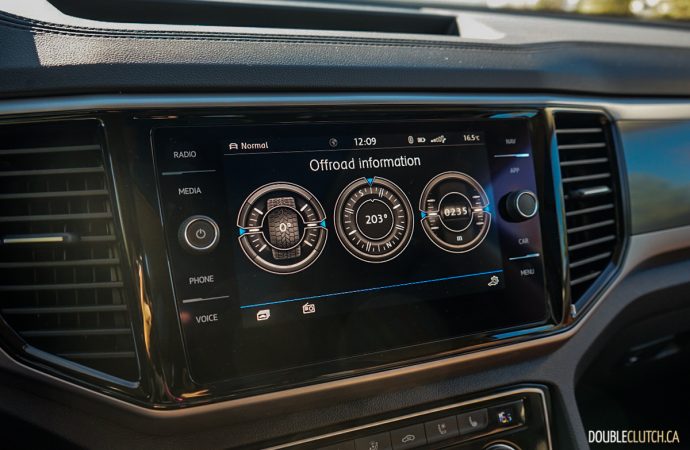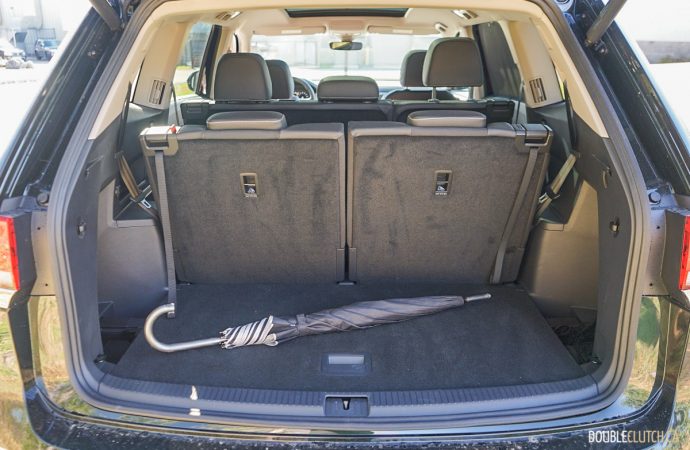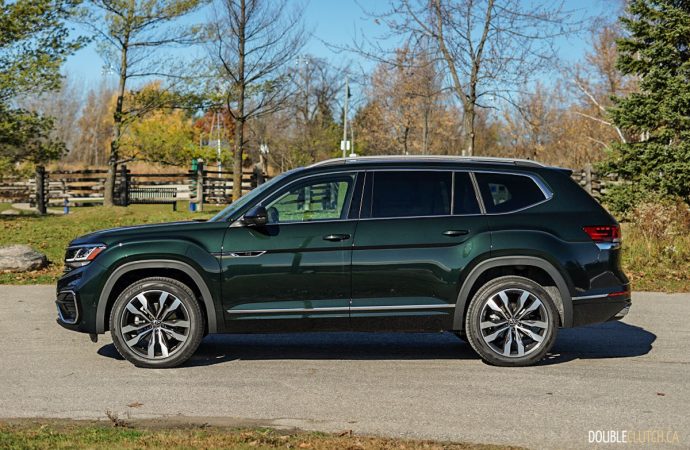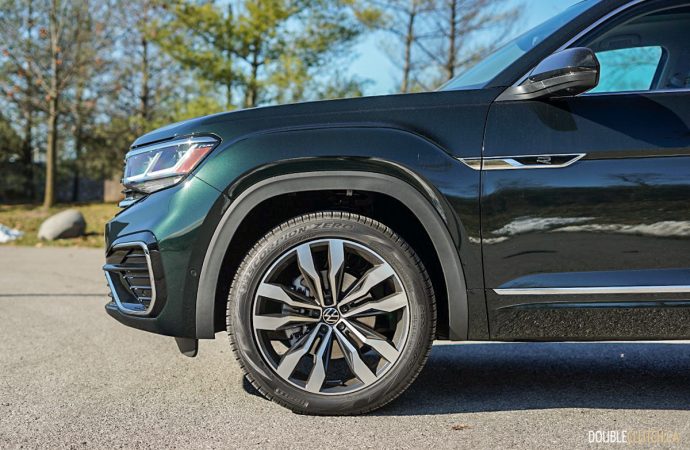The Volkswagen Atlas was an indirect replacement for the Touareg, the former flagship SUV in Volkswagen line. However, the North American market has a big appetite and customers wanted something bigger. The Atlas is an American-built SUV designed for the North American audience. As a result, it’s one of the largest SUVs in the segment. This year, after a mid-cycle refresh, we are excited to have a top-dog 2021 Volkswagen Atlas Execline with the R-Design package on test.
One of the key updates to the 2021 Atlas is a new fascia. The new grille has a three bar design with chrome accents flowing into the headlight design. The headlights now have sharp L-shaped LED daytime running lights. Lights now angle slightly upward into the bold fender line for a more aggressive and sharper look. Our tester was equipped with the R Design package which adds a fully painted front bumper with larger openings at the bottom with piano black and chrome highlights.
In R-Design guise, the Atlas has only limited plastic cladding over the wheel wells, and the side kick panels and rear lower valences are dressed in piano black. The wheel arches are filled by a set of 21-inch two-tone machine finished wheels. The result is a much more polished and sophisticated exterior, especially dressed in Racing Green Metallic. The Atlas’s looks rival much more expensive crossovers in the luxury segment.
The interior at first glance is excellent with clean lines with no bulges, swooping lines or multi-tiered designs. Some may find it to be a bit dull, but we really appreciate the simple and functional design. In many cases eccentric designs sacrifice usability, while the Atlas has lots of accessible storage. A dedicated set of HVAC controls is a welcomed tradition that many manufacturers are moving away from. It’s located in the perfect spot for hands to reach, and it’s simple ergonomics like this that make the interior a user friendly, no stress, welcoming cabin.
One noticeable and unfortunate fact about this cabin is the peculiar decision to use lots of hard plastics on frequent touch points such as the door handles and center console. This makes the Atlas fall short of what customers expect from Volkswagen products of the past which were close to Audi standards. If you are not one to nitpick, the two tone leather seats, stitched leather door inserts and beautiful leather steering wheel make for a well-appointed interior.
Interior tech is also another area where the Atlas’ cabin feels modern and upscale. The infotainment screen in the middle is an eight-inch display with crisp graphics in the interface, but not so much in the navigation map. The interface is crisp and responsive, and intuitive functions mean there is no urge to use Android Auto and Apple CarPlay, but the availability of Bluetooth mobile integration will probably mean most users will default to connecting with their own device.
In Execline form, the Atlas is loaded with most of the tech buyers want. Obvious points include ventilated front seats and a panoramic sunroof. A key piece of tech specific to the Execline will be the digital gauge cluster that transforms the traditional gauges into a fully customizable driver info center. Providing full and detailed view of map and navigation, trip information as well as phone and audio details, the display is definitely class leading. This feature also helps reduce distraction while navigation with the onboard system.
Another key advantage of the Atlas is its size – the cavernous interior makes for an excellent family road trip machine. The third row is fully usable even for adults, and the second row can slide forward and aft to allow for comfortable seats amongst all passengers. Cargo volume is close to class leading at 766 liters behind the second row, only falling short to the Chevrolet Traverse at 808 liters. The next behind the Atlas is the Hyundai Palisade with 649 liters.
Even with the third row up the cargo area is still very usable with 512 liters of cargo volume which is actually more than the Traverse. The interior space and cargo capacity further blurs the gap between minivan and SUVs, giving shoppers less cargo compromise by getting into an SUV instead. One of the best traits of the Atlas is that it provides full size SUV levels of cabin space and comfort without the handling penalties of a body on frame vehicle.
Dynamically, the Atlas drives extremely well with superb body control. Body lean and unnecessary motions are kept to a minimum with excellent damping characteristics. Low speed undulations still pose a challenge as there is no way to defy physics; the tall body creates more exaggerated motions when driving over dips at moderate speeds. The 360-degree surround view camera makes navigating the large vehicle in tight spaces a lot more manageable. Along with its car-like handling characteristics, the Atlas is a great companion.
The Atlas comes with two engine choices with the entry level powertrain being a 2.0-liter turbocharged engine with 235 horsepower while our top spec tester is equipped with the 3.5-litre V6 engine with 276 horsepower, paired to an eight-speed automatic transmission. The V6 engine is ultra-smooth with a satisfying growl when chugging along, but 276 horsepower is still not a ton of power for its 4,502-pound curb weight. The healthy 266 lb-ft of torque makes sure you get moving swiftly and overtake with confidence.
The V6 engine is capable enough for a towing capacity of 5,000-pounds. The eight-speed overall is fairly good with smooth upshifts and responsive down shifts when needed. Unfortunately during stop and go, it repeatedly stutters and jerks for an annoying city driving experience. Volkswagen Canada rates the Atlas at 11.7L/100km city and 9.9L/100km highway. Our real world observation was a 12.8L/100km average, and luckily the Atlas only requires regular 87-octane fuel.
The Execline is equipped with all the necessary safety features including blind spot monitoring, rear cross-traffic alert, front assist with collision warning and braking assist. Adaptive cruise control is also paired with traffic jam assists for not only safe but stress free commuting. The Atlas is also equipped with the renowned 4MOTION all-wheel drive, a Haldex based smart system that is constantly shuffling power from front to rear with a front bias to improve efficiency. The system allows the driver to select off-road setting to attrition more power to the rear for a more stable performance in slippery conditions.
The Atlas is a value proposition starting at only $40,095, and our tester is the range topping Execline at $55,595 with a $1,690 optional R line package for an as tested price of $57,285. At this price range you can get into an Acura MDX, which is a bit more stylish but an aged option at the end of its life cycle. Another highly raved option would be the Hyundai Palisade, which is another option is packed with value and luxuries above its class.
The Atlas Execline definitely tugged at my heart strings after living with it for a week, with superb handling and ride quality. Everything has a heft and solidity to it, and the simplistic design and user friendliness to everything makes it a comforting cabin to slouch into and cruise home after a long day at work. It gives you 80 percent of a minivan’s usability, but 110 percent in style and ruggedness for the worst conditions Canadian weather can throw at you.
Overall, Volkswagen does what they do best, play the balance exceptionally. The 2021 Volkswagen Atlas Execline goes about its business checking all the right boxes where it needs to. As the name suggests, the makers of the People’s Car always know what the people want. We highly recommend the Atlas as the people’s wagon for anyone in the market for an honest family hauler.

